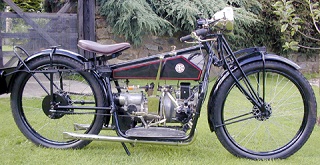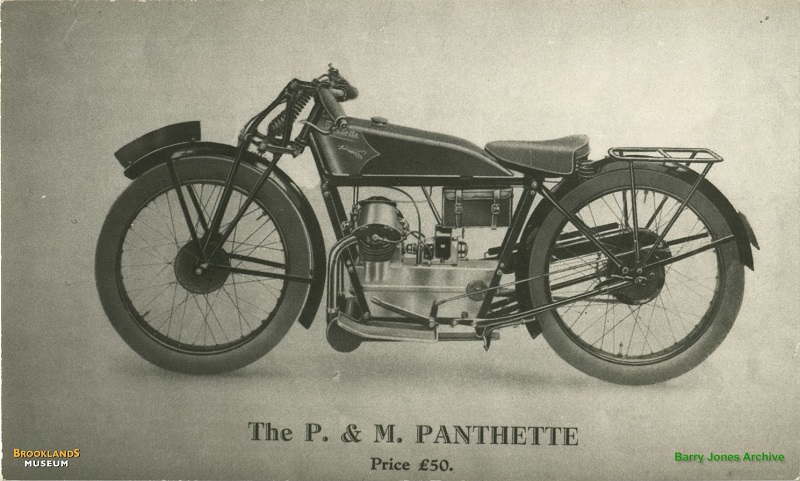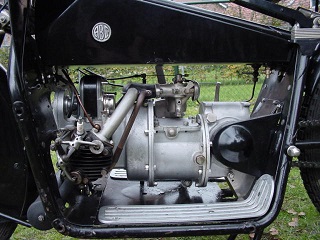When I started to record the lives of the famous 'Tuners' of the motorcycle world, I guessed that about 30 articles would cover the geniuses who had entrapped my youth, when I should have been concentrating on more worthy matters. I had decided that a tuner was one who could bring an existing design to a perfect pitch but I soon realised that there were many designers who had been at the forefront and had then developed their initial design to almost perfection. Think Walter Moore (my hero), George Brough, Peter Williams, or Arthur Carroll for example.
I have included Granville Bradshaw in this series with slight tongue in cheek, because although he was a brilliant designer and marketer, his life's work, as he recounted to 'Motor Sport' in 1960, was to build a better object, prove that it was viable and then move on. He would either sell off his designs, like the ABC engine as the basis of Fitz's R32 BMW, or leave the design to the bean stealers, production engineers and salesmen to market the finished and part-tested product. He only mentions once regretting this style after BMW won their first Tourist Trophy race in the late thirties.
Granville Bradshaw was born in Preston, Lancs, in December 1887 to William Semptimus Bradshaw, a jeweller and optician, and Annie (nee Eastwood). He left school at 13 to work as a solicitor's clerk, whilst studying engineering at night school, before following his brother, Ewan, to the English Electric Company in their home town, and into an apprenticeship. Motorcycling took up much of the brothers' time, and by 1906 they started building their own machines, at first using proprietary engines and frames. After his apprenticeship, Bradshaw moved to Bruce Peebles Ltd. at Edinburgh, as a draughtsman. He studied engineering at Edinburgh University before moving to Vickers in Sheffield. In 1908 he joined the Star Motor Company and was involved in the design of the Star Monoplane and engine. After a variety of different employments, he ended up working with Ronald Charteris, a financier, for the Aeroplane Engine Company. They soon created 'The All British Company' - (ABC) and located in the south of England.
By 1913 Bradshaw had moved to Brooklands, the crucible at the time for aircraft, car and motorcycle design and racing. Still working at ABC, he set up a small design and production workshop there and was soon involved with a fore/aft twin 348cc Douglas that had been entrusted by the Bristol firm to Stephen Leslie Bailey, an Australian engineer. Ridden by the Norton rider, Jack Emmerson, it secured the 350cc records and was the first 350cc machine to exceed 70mph (72.63) in December 1912. Bradshaw designed an ohv 68x68mm, 492cc fore-and-aft Twin by 1913. With a purpose-built frame, Emmerson rode the new ABC to records of 80.47 and 78.26mph for the flying km and mile, and became the first under 500cc to exceed 80mph at Brooklands. In 1913 two 498cc ABC machines were entered in the IOM Senior, ridden (improbably) by H.J. Kay and A.Wray. In 1914 Jack Emerson finished 6th in the Senior TT followed by J. H. Watson on another ABC and Jack Emerson took the 398cc ABC to a 25th place in the Junior ace after some trouble. A 498cc version was supplied to the military from 1914 with a weight of 230lbs and a three speed gearbox. Interestingly, the cylinders were machined from a solid billet. It was good for 60mph, after some de-tuning of the Emmerson record-breaking engine. With the outbreak of war in August 1914, the ABC motorcycle operation, with six engineers, moved to Hersham, only three miles from Brooklands.
During the war Bradshaw worked on aeroplane engine design, culminating with the Dragonfly Rotary aero engines. These were developed by the Air Ministry and put into service by them without proper testing. In the event the Air Ministry recommended him for an OBE for his design work and paid him a large sum for his patent.
He was also responsible, after the war, for the ABC car, the Belize-Bradshaw car, a range of oil-cooled engines, the P&M Panthette, the first scooter and many innovative designs. of all his engineering inventions, perhaps for motorcycle enthusiasts, the most famed was the 398cc (68.6 x 54mm) Twin ABC motorcycle, of which some 3,000 were reportedly made from 1921, although this figure has been disputed. Likely inspired by Les Bailey, who prepared the 350cc horizontally opposed Douglas, with Bradshaw, the post war bikes were constructed by the Sopwith Aviation Company at Kingston-on-Thames and included just about every specification and sought-after feature of its day: unit construction, four-speed gearbox, chain drive, single plate clutch, OHV horizontal opposed engine, duplex sprung frame, aluminium pistons, spherical combustion chambers, internal expanding brake. They were light as well, at 175lb and included leg shields that formed part of the frame. So what went wrong? Well, they took a long time coming, so much so that most prospective buyers cancelled their deposits; it was expensive at £160 about (£12,000 now), and to be fair was not fully finished at the point of sale. It certainly created an initial impact, such was Bradshaw's status as an engineer/designer. Two of the 398cc ABCs competed in the IoM Senior TT in 1920 (E. S. Abram and R. Lucas) with megaphone exhausts fitted (a first), but did not finish.
However, Arthur Bourne ('Torrens' of 'The Motor Cycle' magazine), records that no less than 13 members or his City & Guilds engineering motorcycle club (out of 50 members) owned a 398cc ABC in 1923, with varying success. There was no doubting 'Braddle’s' talent for invention, be it aircraft, engines, scooters or woodscrews — unfortunately his talents were not known in producing the final object. or as James Sheldon remarked, 'Only Bradshaw could have designed the ABC; only Ford could have organised its production; and only Morris could have sold on the scale necessary for financial success!". Produced in 1921, it was soon out of production leaving Braddles, by now a freelance engineer, free to keep inventing. Great Success came of his thief-proof wood screw, sold to GKN at an enormous price. Sadly, he invested everything that he owned into City of Wakefield stock which had, unknown to him, been forged by Clarence (Charles) Hatry, who was declared bankrupt and jailed just prior to the Wall Street crash in October 1929. Braddles lost home, work and reputation in trying to recover his loss leading to temporary bankruptcy in 1936.
Mention should be made here of Bradshaw's work on the Phelon and Moore (P&M) Sloper engine in 1924 - the Panther, a name to be assumed by the factory in 1939. Bradshaw was impressed by the design of the engine which he upgraded to a fully-enclosed ohv layout. This design of engine was used until the firm went out of production in 1962 and was favoured by sidecar drivers. Tommy Bullus (aka Tom Frederick) rode to a 4th place in the 1925 TT but as a newcomer most likely on a pre-Bradshaw machine. The ABC engine did receive some help when Tommy Sopwith engaged Walter Moore, the chief designer at Douglas, to work on the engine. Bradshaw had later denigrated Sopwith as being only a wooden aircraft manufacturer and absolved himself of any shortcomings of his 398cc design. In the event, private owners managed to make something of the ABC, even though out of production, by renewing parts such as valves and pushrods with proprietary kits. In fairness to Sopwiths, there was a dearth of good quality steels around at this time. However. the little ABC was innovative, and surprisingly fast and smooth, running off a string of records at Brooklands and popular with well-to-do cliental, Sopwith Aviation went into voluntary liquidation in 1923, possibly to avoid back-payments for grants made by the government during the war.
The 398cc ABC did form the basis of Max Friz's R32 BMW, when copyright was exchanged, that was the sensation of the 1923 Paris show and thus the essential design of Bradshaw's engine is still being produced today. Friz, who had already reversed engineered the 1914 500cc Douglas to make the M2B15 BMW, mounted his engine transversely, unlike the Douglas and ABC, but it followed Bradshaw's tradition of lightness, smoothness and machining to aircraft specifications. Bradshaw's dealings with Hatry ended with jail for Hatry and bankruptcy (in 1936) for Bradshaw, which he had removed by 1938. In his inimitable style he had again made himself a millionaire with a series of amusement arcade gaming machines, but managed to lose this bonus again, as he did before with his multi-million (by today's money) payoff for government cancelled contracts that his WWI Dragonfly had earned. He continued to design a wide range or items, including motorcycles and components. He supplemented this income as a lecturer before working for the Admiralty during WWII.
By now, at 58 and twice divorced, he concentrated on cars after WWII, as well as the toroidal engine that dominated his interest for the next 15 years. This was a 'one stroke' engine with four pistons chasing each other around a circular bore, and ports feeding mixture and exhausting the gases. Although it was never fully realised, it led Bradshaw to compete the research with the single lobe, rotary engines of NSU Wankel that ultimately (after his death in 1969) led to the Norton NR588 Rotary engine that won the Senior TT in 1992. Had Bradshaw's design been successful, it would have created a worse headache than the rotary NR588 for the ACU committee in classifying an engine with an infinite length of stroke.
After two marriages that ended in divorce, although successful in fathering five children, and several fortunes that had dissipated plus a bankruptcy in 1936, albeit not entirely of his fault, Granville lived with Fancesca King from about 1943 until 1964 when he departed and moved-in with his son, Peter Frewin Granville, in Hitchen. He died there in April 1969.
A brilliant and innovative designer, with a roving eye for all aspects of life, Granville Bradshaw must be included in any 'Genius' Club. But he had many detractors. of course, without people like 'Braddles' there would be nothing existing to improve; his work on any project ended just when the 'Tuner' was needed, often with results that would surprise even himself, such as the first TT win of the BMW from his concept of the 398cc ABC.
And ABC? Bradshaw states that in 1910 he suggested the name, 'All British (Engine) Co' because prizes were being offered for 'All-British' planes. His engine took the British duration record and with it the Michelin Cup from Cody by remaining in the air for 8hr. 43min.
Finally. Such was Granville Bradshaw's presence that for every story about him, written by him or recounted by others, there was always another side, so one could never be too certain what really happened.
A great man.
Postscript. There is an excellent biography of Granville Bradshaw written by Barry M. Jones with the help of Granville's son. Entitled 'Granville Bradshaw - a Flawed Genius?' - I have not yet managed to obtain this book which is now out of print, although I understand that it contains many details of his successes and designs. Perhaps the title does not fully reflect his genius of design. Panther publishing ISBN 978-0-9556595-4-6. 288pp.soft cover.
From “Roadholder 416 August 2022” - written by Bill Southcombe – Courtesy of Phil Batten
Part of "The Tuners of a Golden Age" written by William Southcombe and Peter Williams.



